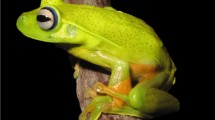Abstract.
Actively foraging lizards use the lingual-vomeronasal system to identify prey by chemical cues, but insectivorous ambush foragers do not. The major clade Iguania includes numerous herbivores and omnivores; among them, two iguanid and one agamine species identify plant and animal foods by tongue flicking, and data suggest that the leiolepidine Uromastyx acanthinurus may as well. We conducted experiments on chemosensory response to food by the herbivorous U. aegyptius. When chemical stimuli were presented on cotton balls in experiment 1, the lizards exhibited greater responsiveness (tongue-flick attack scores) to chemical stimuli from crickets and a preferred plant food (dandelion flowers) than from deionized water. When chemical stimuli were on ceramic tiles in experiment 2, the lizards exhibited greater total tongue flicks to cricket stimuli than to any other stimuli, and to dandelion than to deionized water. Lizards bit more frequently in response to cricket and dandelion cues than to stimuli from a nonpreferred plant (carrot) and deionized water. Tongue-flick attack scores were greater in response to cricket and dandelion stimuli than to carrot or water stimuli. These findings are consistent with the hypothesis that herbivores, even those having ambush-foraging ancestors, use chemical cues to identify potential foods. The data support the hypothesis that chemosensory responses correspond to diet. Because most lizards are generalist predators, studies of herbivorous species can provide important information on possible evolutionary adjustment of chemosensory response to dietary shifts.
Similar content being viewed by others
Author information
Authors and Affiliations
Additional information
Electronic Publication
About this article
Cite this article
Cooper, W.E., Al-johany, A.M. Chemosensory responses to foods by an herbivorous acrodont lizard, Uromastyx aegyptius . J Ethol 20, 95–100 (2002). https://doi.org/10.1007/s10164-002-0061-z
Received:
Accepted:
Issue Date:
DOI: https://doi.org/10.1007/s10164-002-0061-z




